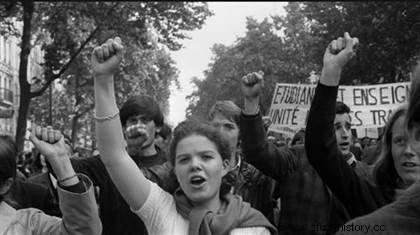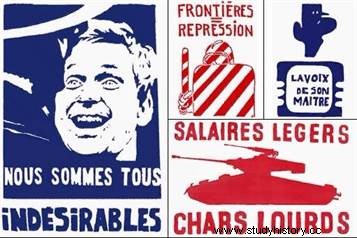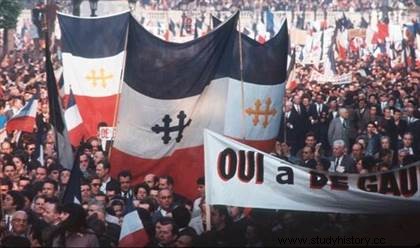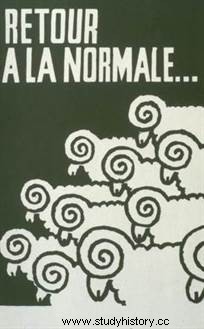 In France, the crisis of May 68 originates in universities where students worry about their future and reject the selection system. At the same time, they express their aspiration for other forms of human relationships, for a liberal evolution of mores and for the abolition of hierarchies. This student protest movement becomes a social movement when the unions in turn call for a strike. After having wavered, the Gaullist power and the institutions emerged strengthened from the ordeal of the crisis of May 68. The latter nevertheless initiated profound changes in French society.
In France, the crisis of May 68 originates in universities where students worry about their future and reject the selection system. At the same time, they express their aspiration for other forms of human relationships, for a liberal evolution of mores and for the abolition of hierarchies. This student protest movement becomes a social movement when the unions in turn call for a strike. After having wavered, the Gaullist power and the institutions emerged strengthened from the ordeal of the crisis of May 68. The latter nevertheless initiated profound changes in French society.
The germs of May 68
All over the world, the spring of '68 was marked by student unrest which crystallized on the protest against the war in Vietnam but, beyond the event, aimed in powerful America at the modern “consumer society”, accused of producing for the sake of producing, without asking the fundamental question of human destiny. In this student unease was to develop a criticism of the University which, both in the capitalist system and in the Soviet system, finds itself increasingly reduced to the role of a factory of executives, distributing knowledge in conformity with standards utilities.
The French crisis of May 68 therefore appears as one of the aspects of a more general crisis of civilization, but it must have been particularly acute in a country which, after ten years authorities of ministerial stability, personalization of power, felt the confused need for a big "party" which would allow him, for a few weeks, to escape from the heavy constraints of modern society. In France, the originally student movement finds its roots in a current of libertarian thought, anchored on the left which denounces a mixture of consumer society, bourgeois values and what is described as “American imperialism”. It is also a reaction to the growing gap between the aspirations of young people and the functioning of higher education, and even of the French social system as a whole. A challenge that is further heightened when trade union demands are added to it, in response to various economic difficulties.
The student revolt
The student revolt, which had been simmering at the University of Nanterre since March 22, 1968, the date of the arrest of some activists from the Vietnam Committee", broke out following of the closure of the Sorbonne on the order of the government and at the request of Dean Roche (May 3). In the eyes of those who witness the scene, this represents an unacceptable violation of the old university franchises:the police cars are bombarded with various projectiles taken from the construction sites of the Latin Quarter. The police, overwhelmed for a moment, retaliated by charging student groups (pushing passers-by and consumers on café terraces in passing) and throwing tear gas canisters which asphyxiated motorists trapped in a gigantic traffic jam. The radios reporting the event live, many students came running, while police reinforcements were sent to restore order:the clashes continued for a good part of the evening.
 The next day, student mobilization grew:the Parisian universities went on strike one after the other, processions form here and there in the capital, punctuated by small clashes with the police. The National Union of Students of France (UNEF), chaired by Jacques Sauvageot, the March 22 Movement of Daniel Cohn-Bendit, the majority of the National Union of Higher Education (SNE-Sup) organize large demonstrations every evening to demand the withdrawal of law enforcement from the Latin Quarter, the reopening of the Sorbonne and the release of imprisoned students. On Tuesday 7, several tens of thousands of students cross Paris, go up the Champs-Elysées and sing "The Internationale" in front of the tomb of the Unknown Soldier. On Friday 10, a considerable crowd literally surrounded the Sorbonne, always "protected" by the police. From May 10, the Latin Quarter experienced several "nights of the barricades", and extremely violent clashes were now linked between the students (from 10 to 30,000) and the police, police and C.R.S.
The next day, student mobilization grew:the Parisian universities went on strike one after the other, processions form here and there in the capital, punctuated by small clashes with the police. The National Union of Students of France (UNEF), chaired by Jacques Sauvageot, the March 22 Movement of Daniel Cohn-Bendit, the majority of the National Union of Higher Education (SNE-Sup) organize large demonstrations every evening to demand the withdrawal of law enforcement from the Latin Quarter, the reopening of the Sorbonne and the release of imprisoned students. On Tuesday 7, several tens of thousands of students cross Paris, go up the Champs-Elysées and sing "The Internationale" in front of the tomb of the Unknown Soldier. On Friday 10, a considerable crowd literally surrounded the Sorbonne, always "protected" by the police. From May 10, the Latin Quarter experienced several "nights of the barricades", and extremely violent clashes were now linked between the students (from 10 to 30,000) and the police, police and C.R.S.
From the Sorbonne to the factories
Surprised as much as the government by the scope of the student movement, at the head of which asserted themselves young anarchist, Maoist or Trotskyist leaders such as Daniel Cohn-Bendit, Alain Geismar, Jacques Sauvageot, the politicians of the parliamentary opposition, the communists, the socialists, F. Mitterrand, P. Mendès France, showed their solidarity. Joined by the unions, a large popular parade brought together nearly a million personnel on May 13, the tenth anniversary of the Algiers putsch which had sounded the death knell of the Fourth Republic. That same evening, the students occupied the Sorbonne. The next day, the working world began to move.
Despite the announcement of the first strikes, General de Gaulle, who did not measure the extent of the danger, undertook a long-planned official trip to Romania. In the following days, strikes with the occupation of factories multiplied in Paris and in the provinces. From the 18th, General de Gaulle had to interrupt his journey and return to Paris. On the 20th, there were 6 million strikers in France. The government, abandoned by the O.R.T.F. who demands the objectivity of information, appeared stunned, apathetic, helpless. The Head of State, who had proclaimed on his return to the capital:“The reform, yes, the shit, no! “, announced, in his speech of May 24 his intention to proceed to a referendum on the participation, but his words only seemed to meet with immense indifference.
 France was suddenly living in the era of direct democracy, in an atmosphere that was not without analogy with that of 1848. After years of "depoliticization", a kind of frenzy of total freedom, of "contestation" took hold of the circles of education, trade unionism, theater, cinema, architecture , literature, the bar, medicine, scientific research, the Church... The major themes of the May movement (university and professional autonomy, co-management, self-management, student power, worker power, etc.) were discussed passionately, in the middle of the paving stones torn up and the cars set on fire by the demonstrators. A flourish of slogans and often imaginative and poetic formulas, reminiscent of the times of surrealism, burst into graffiti on the walls and hastily made posters.
France was suddenly living in the era of direct democracy, in an atmosphere that was not without analogy with that of 1848. After years of "depoliticization", a kind of frenzy of total freedom, of "contestation" took hold of the circles of education, trade unionism, theater, cinema, architecture , literature, the bar, medicine, scientific research, the Church... The major themes of the May movement (university and professional autonomy, co-management, self-management, student power, worker power, etc.) were discussed passionately, in the middle of the paving stones torn up and the cars set on fire by the demonstrators. A flourish of slogans and often imaginative and poetic formulas, reminiscent of the times of surrealism, burst into graffiti on the walls and hastily made posters.
We discussed at the Sorbonne, at the Odéon transformed into a permanent forum, in offices, in factories, in the streets. This movement went far beyond politics and completely escaped professional politicians. From the top to the bottom of society, a huge question arose about the meaning of the world, of culture, of social and personal life. The Prime Minister, Georges Pompidou, let himself be a little carried away by this movement when he declared that “things would never be the same again”.
Grenelle agreements
However, the Fifth Republic had to be saved by the absence of a common political project among its opponents. The student revolt had immediately found strong sympathy among the trade unionists of the C.F.D.T. On the other hand, the C.G.T. and the Communist Party, considering that there was no real revolutionary situation in France, saw in this irruption of leftism (denounced in its time by Lenin) the number one danger. While following the movement, CGT members and Communists were determined to bring it back to the terrain that was familiar to them, that of workers' demands. This attitude, moreover, corresponded well to the sentiments of the majority of the working class, which in no way dreamed, like the students from the bourgeoisie, of bringing down the "consumer society", but rather of obtaining a fairer distribution of its advantages. Between the students and the intellectuals, who aspired to a radical revolution (both spiritual and social, and quite anarchist in orientation) and the mass of the working class, who essentially demanded wage increases, improved working conditions, the divorce escalated rapidly.
 Cleverly taking advantage of this situation, Pompidou forced employers to make very significant concessions during the Grenelle agreements. these provide in particular for a large increase in the minimum wage (approximately 35%), an increase in other wages of approximately 10% to be carried out in two instalments, the recognition of the company trade union section, the reduction of the moderating ticket for the Social security, payment at 50% of strike hours; also envisaged is the reduction of one hour in the working week, better staff training, the upgrading of the pension of old workers.
Cleverly taking advantage of this situation, Pompidou forced employers to make very significant concessions during the Grenelle agreements. these provide in particular for a large increase in the minimum wage (approximately 35%), an increase in other wages of approximately 10% to be carried out in two instalments, the recognition of the company trade union section, the reduction of the moderating ticket for the Social security, payment at 50% of strike hours; also envisaged is the reduction of one hour in the working week, better staff training, the upgrading of the pension of old workers.
The Gaullist regime is wavering
For the "revolutionary" elements who want to make this vast movement an instrument for challenging capitalist power, as for most of those who would like to obtain substantial changes concerning the working conditions and the definition of tasks, these are only a few “quantitative” advantages which will evaporate with inflation. Rejected by the base which disavows the trade union leaderships, they will not be signed, but a certain number of provisions will however be applied (in particular concerning salary increases).
The situation therefore appears totally blocked. Moreover, this same May 27, a new student demonstration followed by a large meeting at the Charléty stadium took place at the call of the UNEF, the PSU of Michel Rocard, and part of the CFDT; Pierre Mendès France attends. The comments made there claim that the solution to the crisis is “revolutionary”. It is true that nothing works anymore in the country and that, within the high administration as in the ministries, the persons in charge “prepare their suitcases”. However, the traditional political class did not want to be overwhelmed:the next day, May 28, François Mitterrand gave a press conference during which he noted the vacancy of power and proposed the constitution of a provisional government chaired by P. Mendès France; he asks for the election of a new President of the Republic and also poses his candidacy. Likewise, the Communist Party, denouncing the “anti-communism” of the leftists of Charléty, calls for the formation of a “popular government”.
Will the power of the streets and working-class determination get the better of the regime and the "most illustrious Frenchman"? We can think so when, on May 29, “well-informed” circles learned that General de Gaulle had left the capital for an unknown destination. We will learn that he traveled by helicopter to meet General Massu, Commander-in-Chief of the French forces in Germany, in Baden-Baden. We will never know why. Was he going to ensure the loyalty of the army? Or was it a staging intended to create a fear of emptiness favoring its return?
The Gaullist victory
 At the end of May, in Paris and especially in the provinces, the weight of the "silent majority", which, stunned by the brutality of the crisis, had passively witnessed the demonstrations and the violence, but felt growing irritation at the paralysis of the country by strikes, by the closing of banks, the stoppage of transport in common, the lack of gasoline. General de Gaulle, comforted by his contact on May 29 with the military leaders of the troops stationed in Germany, then decided to return to the scene. On May 30, when many observers in France and abroad were already awaiting the news of his resignation, he gave a very energetic tone in a brief radio speech in which he announced the indefinite postponement of the referendum, the dissolution of the National Assembly and new legislative elections. This speech was answered a few hours later by an imposing demonstration of a million Gaullists in the Avenue des Champs-Elysées. The very next day, the government achieved great psychological success in ensuring the distribution of gasoline. However, work in the factories only resumed very slowly, in the first half of June.
At the end of May, in Paris and especially in the provinces, the weight of the "silent majority", which, stunned by the brutality of the crisis, had passively witnessed the demonstrations and the violence, but felt growing irritation at the paralysis of the country by strikes, by the closing of banks, the stoppage of transport in common, the lack of gasoline. General de Gaulle, comforted by his contact on May 29 with the military leaders of the troops stationed in Germany, then decided to return to the scene. On May 30, when many observers in France and abroad were already awaiting the news of his resignation, he gave a very energetic tone in a brief radio speech in which he announced the indefinite postponement of the referendum, the dissolution of the National Assembly and new legislative elections. This speech was answered a few hours later by an imposing demonstration of a million Gaullists in the Avenue des Champs-Elysées. The very next day, the government achieved great psychological success in ensuring the distribution of gasoline. However, work in the factories only resumed very slowly, in the first half of June.
The institutional left can therefore only accept the verdict of the ballot box. Only the PSU and leftist students denounce the “treasonous elections”. And if they try to establish a united front with the striking workers, the efforts of the CGT to avoid contact with these “uncontrolled and irresponsible elements” are crowned with success. The student “revolutionaries”, moreover very marginal, will not manage to involve the working class in the insurrection. However, on June 7, a high school student chased by the CRS drowned in the Seine after clashes in Renault-Flins. In Peugeot-Montbéliard two demonstrators are shot dead. The Latin Quarter is still the scene of nocturnal clashes where trees are felled and cars set on fire. But these are only rearguard fights. Little by little work resumed in the country. The Odéon was evacuated on June 14 and the Sorbonne on June 16; on the 18th the strike ended at Renault. With the approach of the elections, the country has almost regained its "normal" image.
The end of the May 68 crisis
 While the left showed itself to be deeply divided, the Gaullists focused their electoral campaign on the theme of defending the Republic against communist subversion. Fresh images of student protests and depredations were systematically used to create a climate of “great fear”. The rise of the Gaullist majority, already very clear in the first round of the elections (June 23), turned into a triumphant success in the second round, June 30, 1968:the majority won 358 of the 485 seats in the new assembly. The Gaullist party alone secured the absolute majority of seats, while the left came out politically crushed, the communist party losing 39 seats, the Federation of the left 61 seats, the opposition centrists 15 seats.
While the left showed itself to be deeply divided, the Gaullists focused their electoral campaign on the theme of defending the Republic against communist subversion. Fresh images of student protests and depredations were systematically used to create a climate of “great fear”. The rise of the Gaullist majority, already very clear in the first round of the elections (June 23), turned into a triumphant success in the second round, June 30, 1968:the majority won 358 of the 485 seats in the new assembly. The Gaullist party alone secured the absolute majority of seats, while the left came out politically crushed, the communist party losing 39 seats, the Federation of the left 61 seats, the opposition centrists 15 seats.
Thanks to the concerted action of Georges Pompidou and the main union leaders, the social crisis will find a peaceful solution, after nearly a month of economic blockage. If the crisis of May 68 was over, it had deeply shaken the Fifth Republic and less than a year later, General de Gaulle lost the referendum of April 28, 1969 and decided to leave power. Since 1968, these complex and variously interpreted events have been the subject of numerous studies, and are still frequently used as a reference (positive or negative) by French politicians.
To go further
- May 68, by Maurice Grimaud and Olivier Wieviorka. Tempus, 2018.
- May 68, the impossible legacy, by Jean-Pierre Le Goff. The Discovery, 2006.
- May 68 . A history of movement, by Laurent Joffrin. History Points, 2008.
